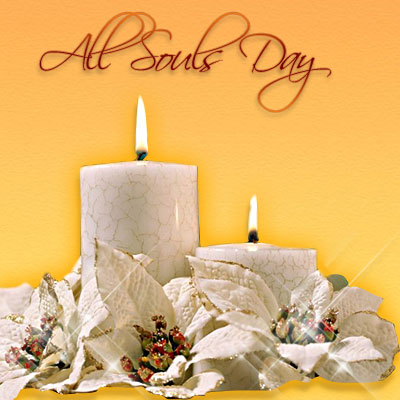In light of the upcoming celebrations of All Hallows Eve, All Saints Day and All Souls Day…
Halloween has a dual origin. It takes its name from its Christian origins. Most popular is the Celtic celebration of the Celtic New Year. The Celtic New Year was about November 1st. They believed on the last day of the year, which would then be October 31st, the lord of death, Samhain, let souls roam the earth. Those who had sinned in life were imprisoned in animals. They could be released by gifts to Samhain, these gifts included human sacrifices. In addition to these souls, evil spirits – demons, witches, etc. – also roamed the earth on this day. It was believed you could dress like them to “blend” in; hence, they would not bother you.
Hearths were extinguished on this Celtic New Year as well. A communal bonfire was held on New Year’s on a hilltop, from which lanterns (gourds) were lit, much like jack-o-lanterns are now, to bring the fire home to re-light the hearth. The bonfire symbolized the driving away of evil spirits with the coming of the New Year.
Today, it is believed, erroneously, the Celtic New Year was called Samhain and pagans celebrating this Celtic New Year will wish others “Happy Samhain”. However, it is merely the celebration of New Year’s and New Year’s eve not the celebration of the lord of death; so, it is unrealistic that the ancient Druids would have wished people a “Happy lord of death”.


Guy Fawkes (1570 - Jan 1606) Guy Fawkes mask
Interestingly, England does still celebrate this time of year with bonfires, but it is not Halloween or Samhain they commemorate. Instead, they commemorate the execution of Guy Fawkes, an English Catholic, who with other Catholics attempted to overthrow the king of England to end Catholic persecution by the king. The British celebrate by sending children out with an effigy of Guy Fawkes, collecting money door to door as American children go trick-or-treating for candy, in preparation for the bonfire. The bonfire is held as a communal event where everyone gathers to watch the bonfire as it is lit, now with the effigy of Guy Fawkes on top. It is unclear why the figure of Guy Fawkes is set ablaze, as this is not how he was executed. He was tortured; then, he jumped to his death before he was able to be hung. Three of his conspirators were hung, drawn and quartered. Fawkes escaped the hanging part, as he broke his neck and died from the jump. While in England living in Bury St Edmunds before Dad got base housing at RAF Lakenheath, we attended at least one of these celebrations. Many know Guy Fawkes from the mask used in the movie V for Vendetta.
As early as the 1st century, people began honoring the people who they thought were holy, most importantly, those who were martyred for their Christian faith. At the time, these holy people were honored on “feast” days, which was the day of their earthly death, but eternal birth. During the 3rd & 4th century, Diocletian persecuted & executed so many Christians, the dates & names became too many. On May 13, 609, Pope Bonafice IV consecrated the Roman Pantheon as a temple of the Blessed Virgin and All Martyrs. Pope Gregory III (731-741) commemorated the feast of All Saints at St Peters on November 1st. Pope Gregory IV (827-844) extended the feast of All Saints to the entire Church.
It remains a holy day and feast day commemorating & honoring all saints and holy people to this day in the Catholic Church.

All Souls Day began in a German monastery on October 1st during the 900s. St Odilio of Cluny’s patronage spread the celebration to other monasteries, then to dioceses. In 1915, Pope Benedict XV granted the observances of Masses. All Souls Day, also known as the Day of the Dead in some countries, is observed throughout the world by Catholics. It is a day you remember and pray for loved ones who have passed, as well as all those souls who have gone before us. It is a special time to honor their memory and offer prayers for their souls.
Because of the dates of All Saints Day and the Celtic New Year, customs of both have melded together when Christians went to Celtic areas – England, Wales, Scotland, Ireland & Brittany (NW France). Initially, the Christians tried to move the New Year’s eve celebration to the original October 1st celebration of All Souls Day to move it away from All Saints Day, but the old Celts continued to celebrate it on October 31st. This led the Christians to try to incorporate it into Christian teaching.
Today, Catholic celebrations of All Hallows’ Eve are held in family and/or parish gatherings where children, as well as some adults, dress up as a saint or holy person such as the pope, Mother Teresa, St Francis of Assisi, any of the holy people named in the Bible, etc. Christians include elements that honor the Christian origins of All Hallows’ Eve & All Saints Day.
So... to one and all, may you have a very blessed All Hallows’ Eve, All Saints Day and All Souls Day. May all the saints pray for you and your intentions, and may the souls of those who have gone before us rest in peace.
God bless… Robyn
